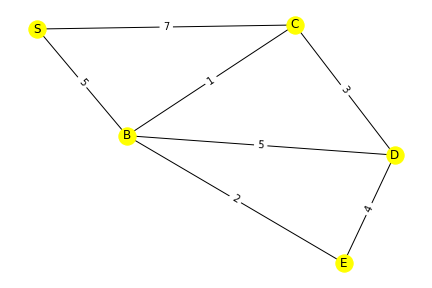Python Teil
Contents
Python Teil#
Aufgabe 1 (5 Punkte)#
Wir betrachten die Funktion \(f(x) = x^3 - 2\) und ihre Ableitung \(f'(x)\) sowie die Stellen \(x = -1, -0.75, -0.5, -0,25, ..., 3\).
Erstellen Sie mittels formatted printing eine Wertetabelle der Funktion \(f\) an den angegebenen Stellen im folgenden Format
x
f(x)
-1.00
-3.00
-0.75
-2.42
etc.
etc.
Plotten Sie \(f\) und \(f'\) an diesen Stellen in grün bzw. rot, mit Achsenbeschriftung und Legende.
Lösung#
import numpy as np
import matplotlib.pyplot as plt
def f(x):
return x**3 - 2
def fp(x):
return 3*x**2
x_values = np.arange(-1, 3.25, step=0.25)
print(" x | f(x)")
print("-------------")
for x in x_values:
print(f"{x:5.2f} | {f(x):5.2f}")
x | f(x)
-------------
-1.00 | -3.00
-0.75 | -2.42
-0.50 | -2.12
-0.25 | -2.02
0.00 | -2.00
0.25 | -1.98
0.50 | -1.88
0.75 | -1.58
1.00 | -1.00
1.25 | -0.05
1.50 | 1.38
1.75 | 3.36
2.00 | 6.00
2.25 | 9.39
2.50 | 13.62
2.75 | 18.80
3.00 | 25.00
plt.figure(figsize=(6,5))
plt.plot(x_values, f (x_values), '.-g', label='$f(x)$')
plt.plot(x_values, fp(x_values), '.-r', label="$f'(x)$")
plt.legend()
plt.xlabel('$x$')
plt.ylabel('$y$')
plt.grid(True)

Aufgabe 2 (2 Punkte)#
Gegeben ist die Hessematrix
Verwenden Sie den Befehl eig aus dem Modul numpy.linalg, um die Eigenwerte dieser Hessematrix zu bestimmen.
Lösung#
import numpy as np
H = np.array([[ 4, -1, 0],
[-1, 2, 1],
[ 0, 1, 6]])
L, V = np.linalg.eig(H)
for l in L:
print(f"{l:.3f} ist ein Eigenwert.")
1.398 ist ein Eigenwert.
4.340 ist ein Eigenwert.
6.262 ist ein Eigenwert.
Aufgabe 3 (4 Punkte)#
Importieren Die das NetworkX-Paket mit Präfix
nx.Erstellen Sie mit dessen Hilfe folgenden Graphen und plotten Sie in inkl. Knoten- und Kanten-Labels:

Bestimmen Sie vom Startknoten S aus die kürzesten Wege und deren Distanzen zu allen anderen Knoten.
Hinweise: Verwenden Sie folgende Befehle und Methoden: nx.Graph, .add_edge, nx.draw, .get_edge_attributes, nx.draw_networkx_edge_labels, nx.shortest_path, nx.shortest_path_length.
Lösung#
import networkx as nx
G = nx.Graph()
G.add_edge('S', 'B', weight= 5)
G.add_edge('S', 'C', weight= 7)
G.add_edge('C', 'D', weight= 3)
G.add_edge('C', 'B', weight= 1)
G.add_edge('D', 'E', weight= 4)
G.add_edge('B', 'D', weight= 5)
G.add_edge('B', 'E', weight= 2)
pos = nx.spring_layout(G, seed=5)
nx.draw(G, pos=pos, with_labels=True, node_color='yellow')
edge_labels = nx.get_edge_attributes(G,'weight')
nx.draw_networkx_edge_labels(G, pos, edge_labels);
import matplotlib.pyplot as plt
plt.savefig("Graph.png")
plt.savefig("Graph.pdf")

nx.shortest_path(G, source='S', target=None, weight='weight')
{'S': ['S'],
'B': ['S', 'B'],
'C': ['S', 'B', 'C'],
'D': ['S', 'B', 'C', 'D'],
'E': ['S', 'B', 'E']}
nx.shortest_path_length(G, source='S', target=None, weight='weight')
{'S': 0, 'B': 5, 'C': 6, 'E': 7, 'D': 9}

